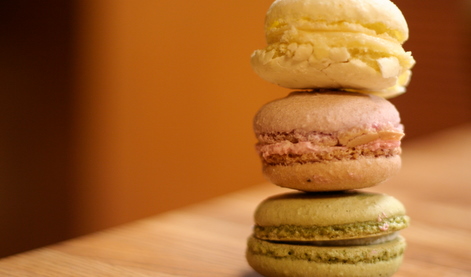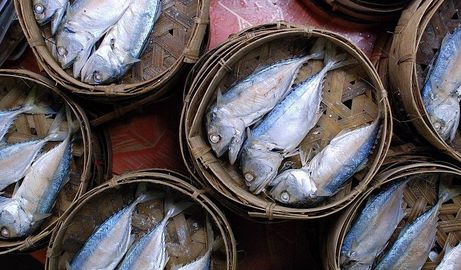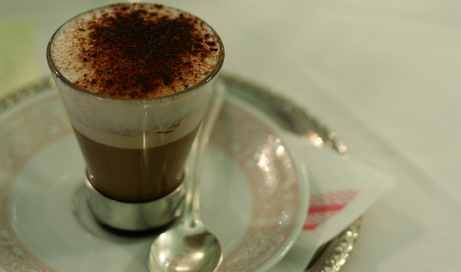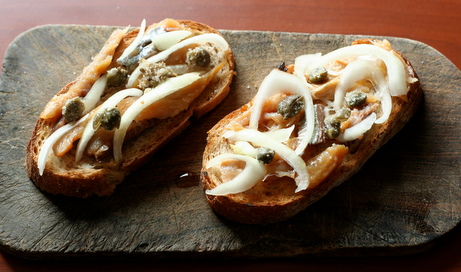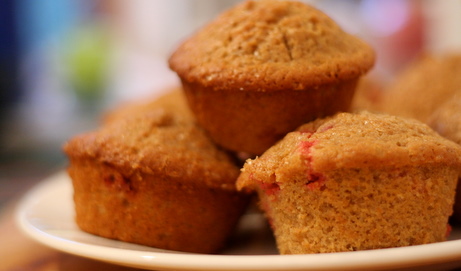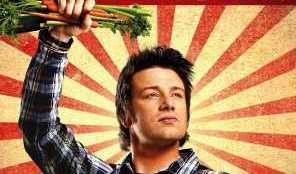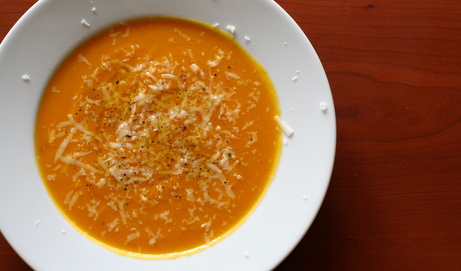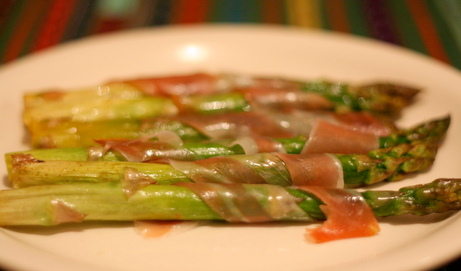Blog
Now I Understand the Macaron Craze
Okay, I get it now. Tonight marked a big moment in any foodie's life--okay, maybe in any woman's life: I tried my first macaron. I couldn't believe I'd waited so long, really, as I tasted them from the bottom up. The bottom, a pistachio macaron with green-tea filling. The next, raspberry, and the top, lemon with lemon creme. Oo la la. I mean, come on, doesn't the pure French-ness of the word macaron turn you on just a little bit? Aren't you just a tad aroused by all the almond meal and egg white glory up there? You're probably thinking, Duh, of course they're amazing. Why'd you wait so long? Well, allow me to explain. Part of it is because they're ridiculously (nearly prohibitively, in my book) expensive. But it goes much deeper than that. You see, the macaron has recently reached cult status, gathering followers and crazed paparazzi on its tail. It's almost as bad as the poor beleaguered cupcake, the Robert Pattinson of the dessert world. It has become an insane little trend. And like Pearl Jam, skinny jeans and taking pics of your food, when it comes to trends I usually show up on the super-late bus. Not because I'm a procrastinator. Not because I'm not punctual. And definitely not because I don't pay attention. Oh I pay attention. I noticed you there a couple years ago with your skinny jeans and DSLR camera, snapping away at cupcakes. But like the first generation iPhone (nope, don't have a smart phone either), hot new trends make me nervous. I don't trust them somehow. I don't want to be left with wall bangs, pegged jeans, and a new bottle of Aqua Net just as you've shrugged them off for your hot new flannel shirt. But this trend--this one actually does make some sense. I finally let my guard down when some friends brought les macarons home from Montclair Baking, the colorful puffs of heaven nestled into a white pastry box. There's something about the macaron...its utter beauty really does make you want to snap pictures of it like a movie star. I think I took over twenty shots for the one I finally chose here. I've made those macarons work for it, sprawled out on plates and stacked on table tops for my voyeuristic pleasure. You must try a macaron at least once in your life, but splurge on the good ones. Everyone should experience the almond meal and crispy sweet exterior that gives way to a flaky, tender meringue and smooth filling, sandwiched between two dreamy pillows. You could even try your hand at making some by following the Parisian-dwelling pastry chef, David Lebovitz's recipe for chocolate macarons here or his general guide here. Or check out my friend Sara's recipes, lemon here or dark mint chocolate (OMG) here). Make them, eat them, love them, photograph them. And then get over it. There are a lot of other cookies out there--and they miss...
read moreChinatown–San Francisco
Whiskey, oysters, coffee, beef jerky. One of the things that most struck me most about my tour of San Francisco's Chinatown was this: the original diet of the San Francisco inhabitants before the Chinese immigrants arrived. I like to imagine a bunch of guys sitting at a make-shift table near the dock, chewing on beef jerky, a pile of pale oyster shells at their feet. It's 1848, and the bone-chilling fog is slowly breaking up under the cold sun. But it's clear enough to see the brig that just pulled into the dock this morning. Clear enough to see the man and woman, the Chinese Adam and Eve of San Francisco, that just stepped onto San Francisco soil. One guy elbows the other, knocking over his coffee tin. "Ya see that?" he says. And the other guy leans forward, peers toward the harbor at the small, dark figures approaching. "What the...?" They never knew what was headed their way. Told by the right storyteller, Chinatown's history is an interesting one, filled with almost Godfather-like details of immigrant families helping each other to survive, struggling against anti-immigration laws and police brutality. The Chinese reached eventual prominence in San Francisco by their sheer tenacity, surviving only by holding on to each other for dear life, like the Pacific Blue mussels clinging to the battered rocks around the Bay. And thank god they stuck it out. Otherwise we'd have been robbed of the dim-sum, the egg rolls, the roasted duck, the rice noodles, the wonton soup. We'd have been robbed of the Chinese markets that swarm with questionable items such as dried shark fin and live pigeons and frogs, shoved in plastic bins and tiny cages.We'd have been robbed of the Buddhist temples, and the streets that are still filled with mostly Chinese residents. We'd have been robbed of that sense that you've stepped into another world entirely as you bump and shuffle through the loud and crowded markets without hearing a word of English. I organized a Chinatown tour for my food writing class with Wok Wiz tours (owned by Shirley Fong-Torres) and our guide, Frank, was fantastic. He told us so many great details about Chinatown's early history. When a new immigrant arrived, for example, an association would give him money, connect him with nearby family, and even help him find work, all in exchange for giving money back to the association when he got his feet on the ground. One of the first places the associations would send residents to were the tiny apartments called SRO's (single room occupancy) where they'd share kitchens and bathrooms and a single rotary phone. If someone received a rare call from China, the SRO building would send runners to your workplace to bring you back home to take the call. (Locals still populate these apartments, by the way, one of the few places with cheap rent in the city.) These family associations existed, in part, because the Chinese faced such fierce racism and strong anti-immigration laws as well as measures designed to stop them from buying up property. The anti-Chinese sentiment was so strong, in fact, that the ground underneath Chinatown was once riddled with tunnels that led to and from homes and shops, so people could escape when the police came looking...
read moreCooking Lessons in Varenna–The Deal of the Century
Pumpkin and Amaretti Tortellini--Oh. My. God. My love affair with Chef Moreno's cooking classes began in April of this year, and I haven't stopped thinking about it since. I had barely squeezed into Italy after a canceled flight due to the Iceland volcano, and so the whole trip had a slightly "I am one of the chosen ones" miraculous feel anyway. But something seemed unbelievably miraculous about this cooking class, which I found online: I learned how to make three different dishes and their sauces: asparagus risotto, handmade tagliatelle with a tomato zucchini sauce, and gnocchi drenched in Gorgonzola cream. Then I got to eat them all. I also ate parmigiano and salami during the break (see photo on right), and had an unlimited amount of wine. Plus he gave us all the recipes for four servings, AND he gave us free pick-up and drop-off at the nearest train station. By the end of the day I'd spent five hours learning about Italian cuisine and anecdotes about the region, I was full on incredible homemade pasta, and--I admit it--I was slightly tipsy. All for 35 Euros. So it's not hard to imagine why I wanted to take one of my best friends, Marsha, to take a lesson when she came for a visit from Romania.The magic of my last trip somehow carried over to this one--we barely, unbelievably really, made all our train connections and ended up at the restaurant early, drinking cappucinos and soaking up the warmth of the quaint and cavernous room. The Lago di Como region is in the north, just at the base of the Italian Alps. What I love best about Moreno is the way he tells stories about the gastronomy of the region, a story that's so important but often lost in the shadow of southern Italy's dominant cuisine. Here in the north, dishes like polenta and risotto are quite popular, butter and cream often replace olive oil, and grains like buckwheat and spelt are often used in pastas. While Chef Moreno says that the cuisine of the south is actually better than the cuisine of the north--I don't know if I entirely agree. They're just different, though after watching the amount of cream, butter, and handfuls of parmigiano he tossed into the saucepan, southern cuisine might be healthier. While he prepared Bocconcini di Vitello, a veal dish, Moreno told us--in English--how most Italians hardly ever ate meat, especially during the early years of the 20th century and before. "Her great-grandmother, once a month, would tell my grandmother to go to the butcher to buy 4 to 5 cents worth of meat leftovers [often organ meats]." When Moreno's grandmother returned with the meat, his great-grandmother would cook the tough organs for hours, softening them, and then serving the meat stew in a depression made in the center of a bowl of soft polenta. Moreno described how they'd grab a pinch of polenta and touch the meat with it and then eat it. The resulting name is Polenta Toccala (touch it). The grandparents and the babies usually got to eat the best pieces of meat--they were the ones who needed the nutrients the most. Even though Moreno's cuisine is fairly traditional, the restaurant reflects Chef Moreno's eclectic personality. A somewhat discomfiting portrait of Madonna...
read moreWhen delicious food meets delicious writing…
My talented friend and fellow M.F.A. graduate Rashaan Meneses recently wrote "Like Fish to Ginger" a lovely and haunting story about a Thai immigrant and the complex chemistry of food and romance. Read the first few paragraphs here, then click on the link for more. It's a beautiful read. The only downside is that now I'm dying for a bowl of curry... Like Fish to Ginger By Rashaan Meneses Before I set out to make my mark in Los Angeles, I chased Sunee. We met in a steamy noodle house in the Dusit District of Bangkok where I elbowed my way from dishwasher to sous chef. Sunee worked as hostess. Both seventeen, she knew exactly what she wanted, and it wasn’t me. Like with a delicate soup, I had to know when to stir and when to let the ingredients meld on their own. For seven months I coaxed her to me, savoring every minute of it, the taste of falling in love. This was all ages ago when cooking was like breathing. What they say about this city isn’t true. There are windows of time when you can fly, like now. The Santa Monica Freeway is as perfectly clear as the skies above, and the Pacific Ocean gleams in the distance. If I pay close attention, the 10 will rise in a sharp incline as I leave downtown behind, and, for a split second, all I’ll see is blue sky swallowing warmth and light. I hold my breath for this ascension, am lifted, and then it’s over soon as it began. I try to focus on the errand my wife has assigned me. Thinking the sunlight has caught my gaze, I notice, almost before passing, a woman standing at the side of the freeway. Tall and lithe, she patiently waits, as if half of Los Angeles wasn’t roaring by at seventy-miles per hour. I park in front of her car then step onto the road to meet, at full force, the shudder of traffic. “Hi!” She shouts over the blare. “Thanks for stopping. It just died on me. Got any cables?” She squints. The sun shines bright above us, and her skin has already deepened from standing out too long. She follows me to my trunk. Her tread so fast, she steps on my heel. “Sorry,” she says with a shy smile and shakes her long blonde hair loose as if she’s just let it down. A nervous twitch I realize. I pull out a car kit. “Wow! You’re really organized.” I shrug embarrassed. “Always be prepared.” “I’m guessing by your accent you probably didn’t learn that in the Boy Scouts.” I laugh and shake my head. “I’m Elise.” She offers a sun-weathered hand. “Pravat Tanawat.” She takes mine in hers. “I really appreciate this, Pravat.” Her voice is throaty as if she’s spent a lot of time in a dry climate. Elise lifts the hood of her car. A constellation of freckles dots her bare neck and shoulders. She looks to be thirty-three, maybe thirty-five at most, much younger compared to my forty-nine. Her long skirt whips up from the force of the passing cars, and I watch a silver pendant dangle and twist from her neck as she helps me clamp the cables. “So, how do...
read moreOrgasm in a Cup: The Marocchino
There are two kinds of people in the world, coffee drinkers and tea drinkers. I am definitely in the tea drinking camp. If you asked me to describe one of my favorite pleasures, I would say: Drinking a cup of tea--black with milk and honey in the morning and mint or rooibos in the afternoon and evening. Add a rainy day, a fantastic novel, snuggling on the couch, or chatting with friends, and I'm as happy as a Milanese woman with a new Furla purse. The problem is, no one really drinks tea in Italy. This is the land of espresso. But it's not like I pictured it would be: people sitting around in cafes, chatting as they savored their cappuccinos and lattes. Oh no. That's France. In Italy, people drink coffee like they drive--friggin' fast. A typical Italian walks into a bar during her morning break, orders an espresso, then stands at the counter and kicks the coffee back like a shot of whiskey. She'll chat with her work friends for a few moments, finish off her brioche (croissant) then head back to work. There is no lingering. Coffee culture is different in the U.S., and in some ways it's a recent phenomenon. I remember many high school nights, when I slipped off to the new cafes that had popped up around the Sacramento suburb my family lived in. My friends and I thought we were so cool and independent as we sipped our mochas, listened to live folk music, and flirted with the boys. It wasn't just me falling in love with the bitter drink: ever since the mid-nineties, with the advent of the Starbucks effect, coffee has become an increasingly large part of American culture. Now over fifty percent of Americans drink at least one cup of coffee a day. Now it's possible to order decaffeinated mochas with soymilk and mint (I know, because I have). But I have to say that despite the appeal of a sticky-sweet pumpkin spice latte (you know you want one), I've become a fan of the less adorned Italian espresso drinks. As one article put it, "Italian espresso drinks are the liquid equivalent of Italian cuisine—dependable, straightforward, and delicious in their simplicity." I think I kinda like simplicity. But which espresso drink do I choose? The cappuccino is nice, but it's too milky and filling for me. And the espresso goes by too quickly; I like to savor my drinks a little bit, like my cups of tea. In fact, I was beginning to think there wasn't any hope for me to enjoy a cup of coffee with my Italian teacher and the other students in my class. I had begun to follow them to the bar only to watch them drink their espressos while I looked on idly, feeling a bit jealous. But then Guido suggested I try a marocchino. And this is why I love my boyfriend: he knows me well. I LOVED IT. My friend Sara, who keeps the Ms. Adventures in Italy blog, calls the marocchino "Heaven in a Cup," but I'm going to refer to it as "Orgasm in a Cup," for reasons that are probably a bit obvious. A bit about this tasty drink. Marocchino means "little Moroccan" in Italian, but don't let that...
read moreSmoked Herring (Kipper) with Capers and Onions
You know the ol' "if you were stranded on an island" game, where you have to choose what you'd eat or what you'd read, which CD you'd listen to, or who you'd take with you? The one where you're forced to think deeply, and perhaps a bit pointlessly about the that you'd want with you forever and ever? Okay, I admit it, I love to play it, especially when hiking long stretches of trail, or waiting for delayed trains, planes, and automobiles. I am usually quite horrible at it though, because when asked, I suddenly forget the name of every musician I love and every book I've ever read. Food though--food I don't forget. I remember thinking long and hard about that one when asked a few years back. I thought about squash soup, dark chocolate, bread warm and fresh from the oven with butter spread on top...mmm...and the list goes on and on. But I finally decided that I'd be willing to live off of wild berries (we were being a bit generous with our categories) and smoked salmon. Yup, basically the diet of an Alaskan Grizzly bear. I mean, I just love smoked salmon (aka lox), don't you? I have been known to buy packages of the stuff and eat every slice in one sitting with my bare hands, dangling the buttery, salty, tender pinkness just at the edge of my lips before eating it slowly, with a ridiculous amount of pleasure (dare I say orgasmic?). But lately I can't help but feel guilty about this succulent treat, because the fact is, salmon fishing is not so great for the planet. Farmed salmon are kept in pens on the edge of the ocean, are fed bad diets, and the excess pollution that comes from the concentration of fish is really harmful for the ocean (much like waste from high-density cattle farms polluting nearby streams and other water sources). Wild-caught salmon is much better for you and the ocean (in fact, Wild Alaskan Salmon is highly recommended by the Environmental Defense Fund, but usually quite pricey). In general though, salmon is also over-fished, resulting in declining salmon populations which is also not so great for the planet (cool article about wild salmon conservation and why it's important here). Don't eat this Kipper. So what's a Grizzly bear to do? Well, the real ones can go on eating whatever salmon comes their way, but I...sigh....have started looking for substitutes. But I've got good news, folks. I just discovered my new favorite smoked salmon substitute! Ladies and gentleman, allow me to introduce you to...Kipper! It's the pickled or cold smoked version of herring, a small fish that the Environment Defense has stated is one of the best for the environment and for your health. Herring, you say? Isn't that a red device used by writers to distract me from something in the story? Why yes! It is. But it also happens to be an actual fish that lives off plankton, which means it consumes much less mercury. While it's not one of the Environmental Defense Fund's top choices, it's considered okay when eaten in moderation. Kipper is not quite considered haute cuisine here in Italy, Guido tells me; he says that the fisherman usually eat them. But then he introduced...
read moreRed Currant Spelt Muffini
No, that's not a typo in the title. Allow me to explain. There are no such things as muffins in Italy. I keep asking around: "Hey--do you guys know what muffins are?" And they do, but only as some distant creation formed in strange tins in the United States. "What do you call them?" I asked my boyfriend one Sunday, as I prepared a batch of muffins for his virgin experience. "We call them muffin," Guido replied. "But what do you call them in plural? When there's more than one?" "Muffin," he said, laughing. "But that's ridiculous," I said. "If you're going to use the American word, then you should have a plural form." I thought for a moment about Italian grammar. Since most foreign words like "film" and "computer" are masculine by default, "muffin" must also be masculine. This means it should have the "o" ending when singular and the "i" ending when plural--if it were a normal word. "From now on," I said, "we'll call them...Muffini." And thus, amidst a storm of laughter, Muffini were born. Though I'm not celiac, I'm definitely sensitive to wheat and sometimes gluten altogether, depending on the day. So I was so excited to find spelt flour in our nearby health food store which usually doesn't bother me. I searched high and low for a simple spelt recipe that didn't call for ten million, hard to find ingredients like yogurt and applesauce, and found the base for this one here, on the King Arthur Flour website. I'm not against complicated recipes, I just don't always have the ingredients in my fridge, and I'm also starting to like the Italian philosophy of keeping it simple. Muffins are a favorite for me because they're easy to make and very tasty with a little fruit added. I'm a big berry fan; I love the burst of tartness surrounded by sweet, warm muffini-ness. But you could probably substitute some other fruit if you adjust the recipe a bit. These would also be fabulous with a half cup of walnuts or, even better, pecans...mmm... Red Currant Spelt Muffini Servings: 12 to 14 muffins Ingredients (in order of appearance): 2-1/4 (280 g) cups spelt flour (farro in Italy, or you can also use whole wheat) 1 Tbs baking powder 1/2 tsp salt 3/4 cup (150 g) cane sugar (or white) 1/2 tsp ground cinnamon 1/4 tsp ground nutmeg 3 eggs, beaten 1 Tbs vegetable oil or melted butter 1 tsp vanilla extract or vanilla powder (if you add powder, mix it with the dry ingredients) 1-1/4 cups (300 ml) milk G-Spot Ingredient: 1 Tbs of grated orange rind (the rind of one large orange) 1 cup (150g) red currants* 1/2 cup walnuts or pecans (optional) Optional but yummers!: A little sugar to sprinkle on top of each muffin, right before you put them in the oven *Note: Halved raspberries, white currants, or gooseberries are excellent substitutes, as are blueberries or halved blackberries. But if you use a sweeter berry, cut the sugar down to 1/2 cup or 100g). If you use wet or frozen berries, I highly suggest you coat them with a little flour, which helps them stay in the mixture without sinking to the bottom of the pan. Preheat your oven to 425°F (220 C). Grease...
read moreWhy I have a crush on Jamie Oliver
If you live in the States, I'm a little jealous. Not just because you're closer to my family, but because you can watch a television show that I am completely in love with: Jamie Oliver's Food Revolution. I am not the kind of girl that watches television--in fact, I've never owned one until I moved in with Guido, and we only used our basic cable once to watch the World Cup (Hey, I'm in Italy, what can I say?). So, thank goodness for airline entertainment. I was fortunate enough to watch the Food Revolution while traveling over the Atlantic on the way back from the United States. After watching the forty-minute pilot episode, I was totally inspired and moved by Jamie's mission to transform the unhealthy eating habits in the United States. Now this is the kind of television I can get behind. Here's the premise of the show: Jamie travels to Huntington, West Virgina (population 50,000), recently named the unhealthiest city in America because of its high rate of obesity-related deaths. A 2008 report from the Center for Disease Control reported the following facts on Huntington: 45.5% of the residents over 20 were overweight (that's half!), 21.6% of those over 45 reported a diagnosis of coronary heart disease, and 13% of those over 18 had diabetes (the national rate is 7.8%). Jamie's goal is to try to get the residents to change their addiction to fast and unhealthy food and show them that with just a little extra effort their lives can be healthier and much, much longer. The show is packed with insight into our American diet. It highlights what we feed our kids across the country--because let's face it, it's not as if the residents of Huntington are the only ones addicted to fast food. But I was must struck by the emotional chords struck during the show; I was riveted while watching the various conflicts between Jamie and the town's residents that felt understandably judged and embarrassed by the spotlight on their diets. I was moved by the intense emotions the locals expressed when they realized the processed foods they feed their kids could literally take years off their children's lives. One moment you HAVE to watch (I included the Youtube below) is when Jamie goes into a classroom with a group of 1st grade school children and tries to get them to identify basic fruits and vegetables. "Who knows what these are?" Jamie asks as he holds up a bunch of dark red tomatoes. None of the kids knew. "Potatoes!" One kids yells. Another gets up real close and squints and then shakes his head. "I dunno." Then Jamie yells out, "Who knows what ketchup is?" And all the kids' hands shoot into the air, huge smiles on their faces. Tomatoes, people. We're talking about tomatoes. This is nothing new to Jamie (yeah, we're on a first name basis...), who was recently named Britain's "Food Czar" and asked to transform the student lunches throughout the U.K. He also put his house up as collateral (without telling his wife), so he could fund The Fifteen Foundation, which takes fifteen young adults every year from disadvantaged backgrounds with criminal and drug abuse histories, and trains them in the restaurant business. In Decemeber 2009, Jamie won the...
read moreSimple Squash Soup
I miss my dad. This time of year my dad and I both really love cooking and planning our big family gatherings like Christmas and Thanksgiving. Now that I'm in Italy, we'll have to plan our separate menus over the phone. Living in Italy is really wonderful, but I can't lie--being away from my family during the holidays hurts. One dish my dad and I love to prepare this time of year is squash soup. It was a tough decision in the past, because he and I were the only ones who really enjoyed it. Growing up, my brothers were so much younger (by six and nine years) that the flavor didn't appeal to them. My mom wasn't crazy about eating a sweet soup either. In her mind, soup should be savory--like the gumbo she grew up with in the south--and squash soup was a strange anomaly that rebelled against her philosophy and taste. Squash soup was right up there with tapioca, or fish eyes and glue, as she used to call it. I've come to realize that cooking is not just an art for my dad, but also a form of love and service. Because he had a philosophy that we ate meals as a family and we ate what he put on the table, he usually preferred to make dishes that everyone would enjoy, not just one person. But when I came home from my first year of college and proclaimed that I was a vegan, holidays got a bit more complicated. Suddenly, he had a family member who couldn't eat turkey or the other meats he usually prepared with such love. Suddenly he had to figure out how to serve just me. Looking back, I think it's partly why I love squash soup so much. It's not just the creamy texture, the vibrant color of fall leaves, or the perfume and taste of autumn that lingers long after I've finished. There's something more emotional behind my attachment. It's about remembering being a young woman, trying out a new identity, even rebelling a bit against my father's cuisine. I remember my father's face when I told him about my decision to be vegan, the look of disappointment and the sense of rejection. My dad is very emotionally connected to his food, and in a sense, rejecting his food was a way of rejecting him. We also used to be conspirators in the kitchen: I watched him cook, I listened to his stories about cooking, I ate everything he made with gusto. By choosing to be vegan, I'd abandoned him for my own path. I'd chosen to eat on my terms, not his. I wasn't sure what my dad would do after I told him; in truth, I was a bit scared. But he recovered after a while and announced that he would make a big bowl of squash soup to substitute for my portion of turkey. I distinctly remember breathing a sigh of relief, and eating my bowl of soup at Thanksgiving dinner with an extra helping of gratitude. Now that I'm a bit older, I understand just what that squash soup meant. By making that soup, my dad gave me the gift of my independence by allowing me to experiment with a path that went against...
read moreRoasted Asparagus Wrapped in Prosciutto
Moan alert. Of all the things Guido and I have prepared since my arrival, I have to say that this is one of the most orgasmic recipes, moan-worthy recipes I have to offer. And the fantastic thing is that it is oh so simple. Yesterday Guido and I went to the questura, which is the Italian word for "hell" (okay, it's what they call the local police station). I'm in the process of finishing the fabulously labyrinthine process for my permesso di soggiorno, which is sort of like my green card/identity card for my next year in Italy. Anyway, we had an appointment slip for 8:16am and thought that we'd walk right up to the window at the ever so exact time printed on the paper. I mean, why else would they say 8:16am, unless that time slot was specifically for us? We showed up around 8:16, only to find out that everyone else in Monza, our city, got the same appointment time, or something within 30 seconds of it. We had to pick a number and wait until it was our turn, and since the number counter currently said 66 and we were 88, things didn't look so good. One hour after our arrival, they'd made it to 68. Italian classes for the day? Out the window. Guido's day of work? Dream on. Government offices do not bring out the best in my otherwise patient and Buddha-like boyfriend. The inefficiency and apathy drive him nuts. After living in Turkey and the Philippines, I tend to just shrug it off, but Guido likes to pace around the room (imagine a very, very small waiting room at a DMV) and analyze what each clerk is doing, how efficient they're being, and what is causing the holdup. Then he reports back to me with updates: The computer broke down--can you imagine? The computer in a police station doesn't work. Then: Some guy just gave a lecture to five people for fifteen minutes--why? Who knows. Followed by: The only clerk working has been on the phone for thirty minutes. I said thirty minutes. A string of quietly muttered expletives followed, as the hours ticked slowly by. I had to get Guido out of the waiting room, so we slipped out for a cappucino and brioche (Italian croissant) three hours after our arrival, sometime around person 75. During the refreshing walk we passed one of my favorite things ever: a corner vegetable store. I dragged Guido in after the coffee and we wandered around the small shop for a few minutes as I lovingly ran my hands over the beautifully arranged pears--all five varieties of them!--and oggled the dark red endive (gorgeous!) and the plump roma tomatoes. The vegetable I was most surprised to see, however, was a bunch of asparagus propped next to the cash register. Asparagus is a spring vegetable and I still don't know why we found it in the market. Knowing that I likely wouldn't see asparagus again until after winter, we purchased some with this recipe in mind. Thank god for the trip to the cafe and the vegetable shop--we walked back to the questura blissful and happy and got our paperwork processed shortly after our return. But I just keep thinking that if it hadn't been for...
read more
